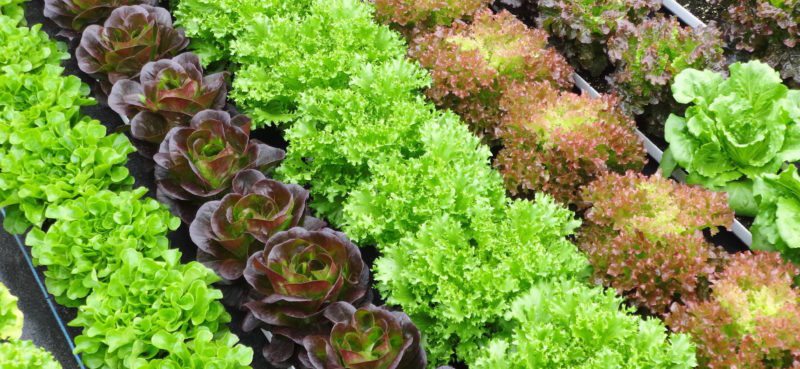
Factors that Influence Leaf Coloration
In the production of most floriculture crops, growers usually focus on quality attributes that relate to flowering, such as flower number and size, as well as plant compactness. The color of foliage is sometimes not considered unless there is obvious chlorosis or necrosis. There are some crops, however, in which foliage color is especially important, such as those produced primarily for their purple, silver or variegated leaf characteristics (Figure 1). This article reviews cultural and environmental factors that influence foliage color.
Fertility. Most macro-nutrients (such as nitrogen and phosphorus) and micro-nutrients (such as iron, magnesium, and manganese) regulate leaf coloration. Plants with inadequate nitrogen or sulfur can have an overall pale green appearance, while those deficient in phosphorus can have lower leaves with a purplish color. Chlorotic leaves (those with yellowish regions between the veins or at the leaf margins) are often caused by inadequate micronutrients, too high of a substrate pH (see below), or both.
When plants appear pale green or chlorotic, the first thing to do is measure the electrical conductivity (EC) and pH of the substrate, and compare values to the recommended ranges for that particular crop. However, plants grown within the recommended pH and EC ranges can still have a nutritional deficiency if they aren’t able to uptake enough nutrients, such as when a root system is poor or if plants are kept too wet. North Carolina State University has a useful guide on nutritional deficiencies at http://bit.do/nutdef.
Substrate pH. The root zone pH influences the availability of all nutrients. Iron and manganese are less available at a high pH, while most macro-nutrients and molybdenum are less available at a low pH. Crops have been categorized into pH groups based on uptake of nutrients, especially iron. For example, “iron-inefficient” crops such as petunia and calibrachoa aren’t able to utilize some forms of iron and manganese when the pH is too high and thus, the pH should be maintained at 6.2 or lower. At a higher pH, leaves appear chlorotic. For more information, check out this “Iron Out” guide: http://bit.do/ironout.
Plant growth retardants (PGRs). PGRs inhibit extension growth of both leaves and stems. Therefore, plants treated with a PGR usually have smaller leaves while the amount of chlorophyll in the leaf doesn’t change. The result is a leaf with a greater concentration (density) of chlorophyll, which makes the leaves a darker green. An exception can occur from a spray application of chlormequat chloride (for example, Cycocol and Citadel), which can cause temporary marginal yellowing of the newest leaves. Symptoms usually disappear as long as the rate applied isn’t excessive (typically less than 1,500 ppm). While PGRs can create smaller and darker green leaves, an application of gibberellic acid (GA) increases extension growth, potentially resulting in lighter green leafs.
Daily light integral (DLI).
- Green-leafed plants: Plants grown under a high DLI usually have a greater concentration of chlorophyll and thus, can have darker green leaves than plants grown under light-limiting conditions.
- Purple-leafed plants: For many plants with purplish leaves outdoors, they can lack the purple color when grown under a low DLI (such as less than 10 mol·m–2·d–1). The purple coloration increases with DLI.
- Silver-leafed plants: The silver coloration is a protective mechanism to reflect some of the energy from sunlight. Consequently, plants grown under a low DLI can be less silvery than when grown under a moderate DLI (for shadetolerant plants) or a high DLI (for full sun plants).
- Variegated plants: Variegation can be less than desired under a low DLI and subject to leaf burn under a high DLI. Thus, many variegated plants have the highest leaf quality under an intermediate DLI, such as 12-16 mol·m–2·d–1.
Light quality. The radiation spectrum can dramatically influence leaf coloration. For example, blue and ultraviolet (UV) radiation regulate the synthesis of anthocyanins, which cause leaves to turn purple. A red-leafed cultivar may have just green leaves when grown under a radiation spectrum deficient in blue and/or UV, especially when the DLI is low. This is of particular concern when plants are grown indoors, such as in vertical farms.
Temperature. Plants grown at relatively low temperatures tend to have leaves with greater pigmentation, especially when the DLI is low. Under light-limiting conditions, a lower temperature can increase foliage quality, but the consequence is that plants develop slower and so usually take longer to reach marketability.
Erik Runkle is professor and floriculture extension specialist in the department of horticulture at Michigan State University. He can be reached at runkleer@msu.edu.


 Video Library
Video Library 




















